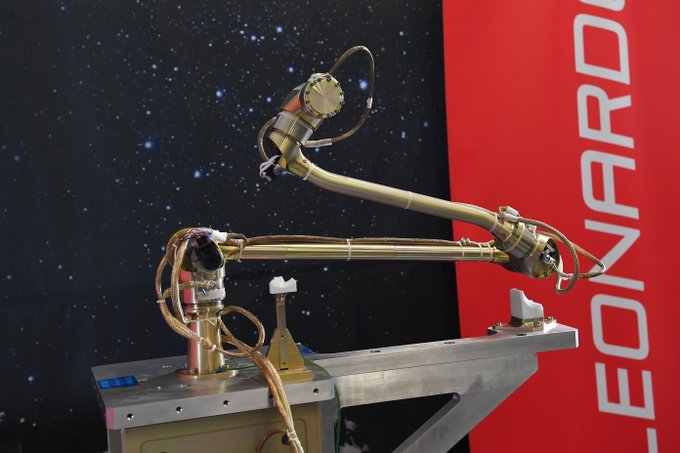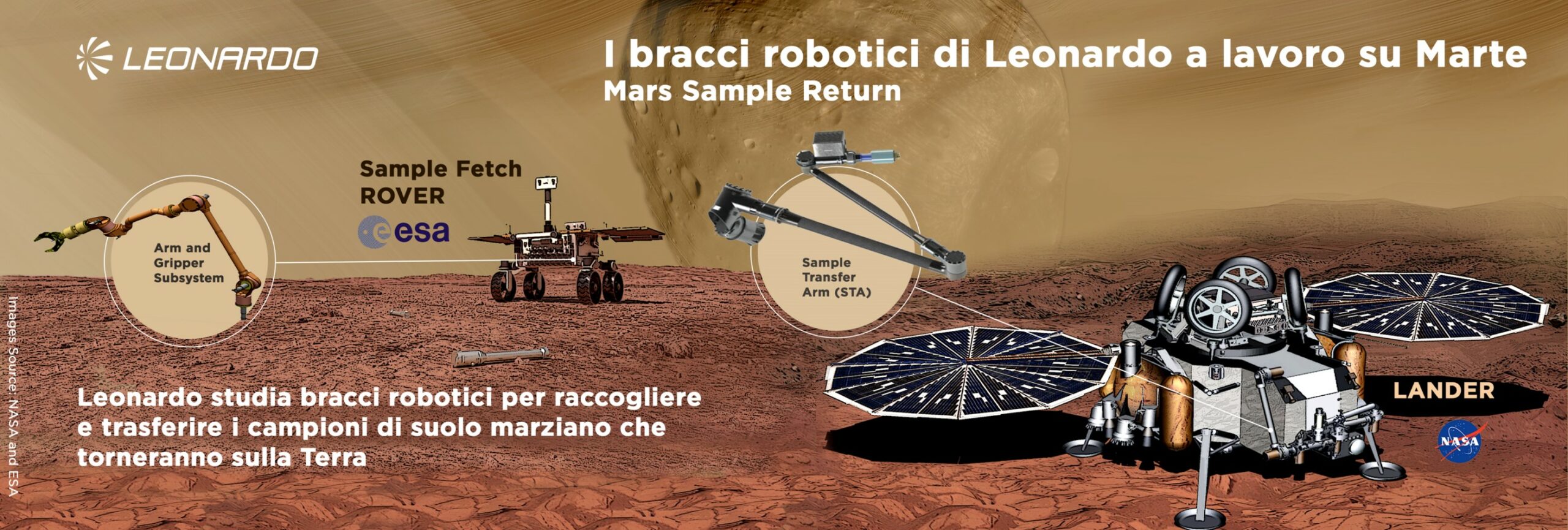What will Leonardo do for the NASA and ESA mission to Mars

Leonardo is engaged in the study of robotic instruments aboard the rover and lander of the NASA and ESA mission to Mars scheduled for 2026. All details
Leonardo at work for NASA's mission to the red planet with the European Space Agency.
As part of NASA's 'Mars Sample Return' campaign, in collaboration with ESA, Leonardo has signed a contract with Airbus for the advanced study phase (Advanced B2) of the robotic arm of the ESA Sample Fetch Rover (Sfr) . The Italian aerospace and defense giant has also obtained funding from ESA to continue the study of the Sample Transfer Arm (Sta) for the NASA lander.
This is what a note reports, explaining that Leonardo, also thanks to the contribution of the Italian Space Agency, is involved in the study of two elements of the 2026 mission of the Mars Sample Return campaign, the rover arm and that of the lander.
For both, Leonardo is now busy designing their respective robotic sample acquisition and manipulation systems.
All the details.
LEONARDO'S COMMITMENT TO ROBOTIC ARMS
The robotic arm of the Sfr rover, whose industrial consortium is led by Airbus Uk, after an initial phase of study and testing, now enters the advanced phase of designing and developing the first prototype (breadboard) to demonstrate the high capabilities of the system. It will be an arm with 6 degrees of freedom that can be extended up to about 110 cm and a gripper, or a pliers, complete with a control system.
The Sta of the NASA lander is instead a more complex arm, with 7 degrees of freedom that exceeds 200 cm in extension and now enters the breadboard development phase. In this case, Leonardo is responsible for an international industrial consortium also responsible for the design of the control electronics, software and vision system.
Both arms are based on the experience gained in the realization of the Delian and Dexarm models, developed by Leonardo, still considered reference standards in the European space market.

THE EXPERIENCE WITH THE ROSETTA, EXOMARS AND LUNA-27 MISSIONS
The former Finmeccanica also boasts a strong knowledge in the field of space drills, designed for missions such as Rosetta, ExoMars and Luna-27.
LEONARDO'S INVOLVEMENT IN MISSIONS FOR MARS
Leonardo is extensively involved in Mars exploration missions, from the 2016 and 2022 ExoMars missions to the Mars Sample Return program. In the latter, Leonardo is studying and designing the two robotic arms that will collect and transfer the Martian samples to the Mars Ascent Vehicle (MAV).
THE OBJECTIVES OF THE MARS SAMPLE RETURN MISSION
By 2031, the Mars Sample Return mission will collect in situ samples from the surface of Mars and return them for study in terrestrial laboratories. Initially the MSR Sample Retrieval Lander will descend to the surface of the planet carrying the Sample Fetch Rover (SFR) and the Mars Ascent Vehicle (MAV). The SFR will collect the samples from the Martian surface that have been stored by NASA's Mars 2020 Perseverance rover and transfer these samples to the Mars Ascent Vehicle, a mini-rocket developed by NASA, which will launch them into the orbit of Mars. At that time, the ERO probe, which will be launched in 2026, will be ready to locate and capture the samples released by the MAV.
After capture, the samples will be sealed in a biological containment system and placed inside the Earth Entry Vehicle. ERO will leave Martian orbit and return to Earth. Upon returning to Earth orbit, ERO will release the Earth Entry Vehicle which will be recovered and the sample will be analyzed.
THE CONTRIBUTION OF THALES ALENIA SPACE
For Msr, Leonardo will also contribute to the Earth Return Orbiter (Ero) through Thales Alenia Space who will be responsible for providing the communication system that will allow the transmission of data between Earth, Ero and Mars. It will also design the Orbit Insertion Module and manage the Assembly Integration and Test (AIT) phase for the Proto-Flight model of the Ero probe, in its clean rooms in Turin and Toulouse.
The joint venture between Thales (67%) and Leonardo (33%), has in fact signed with Airbus Defense and Space, prime contractor of the program, the Authorization to Proceed (Atp) to contribute to the development of the Hero.
The first tranche of the contract of approximately 11 million euros will cover the first development and design activities, while the global contract value is approximately 130 million euros.
"SUCCESS OF ITALIAN GOVERNANCE"
Ero, the Earth Return Orbiter, represents “a key element of the mission”, underlined Tas Adnkronos CEO Massimo Comparini. “Thales Alenia Space will bring his great experience in the exploration of Mars, obtained from the leadership role for the 2016 and 2022 ExoMars missions in search of life on the Red Planet. The Trace Gas Orbiter launched in 2016 in orbit around Mars, is analyzing the Martian atmosphere before becoming the communications catalyst for all future missions landing on Mars ”.
With our space innovations “we can say that Italian technology travels and explores the solar system”. Tas has in fact signed two new millionaire contracts for future missions to the Moon and Mars.
In addition to the involvement in Mars Sample Return, yesterday ESA announced the choice of Thales Alenia Space for the supply of two main modules of the future lunar space station, pillar of NASA's Artemis program. The first tranche of the I-Hab contract, (worth 36 million euros, the total amount is 327 million euros) was signed with ESA.
"For the future mission to the Moon, these are the two main modules of the station that will be in cislunar orbit, the Lunar Orbital Platform – Gateway". In particular, the CEO explains that the joint venture between Thales and Leonardo will develop “the I-Hab module, the International Habitat, where the astronauts will be hosted, and the Esprit module for communications and refueling”.
These contracts "are the children of the investments made by Italy at the Seville ministerial" – pointed out Comparini – are the industrial fallout that arise "from Italian spatial governance".
This is a machine translation from Italian language of a post published on Start Magazine at the URL https://www.startmag.it/innovazione/che-cosa-fara-leonardo-per-la-missione-nasa-e-esa-su-marte/ on Wed, 14 Oct 2020 06:38:09 +0000.
